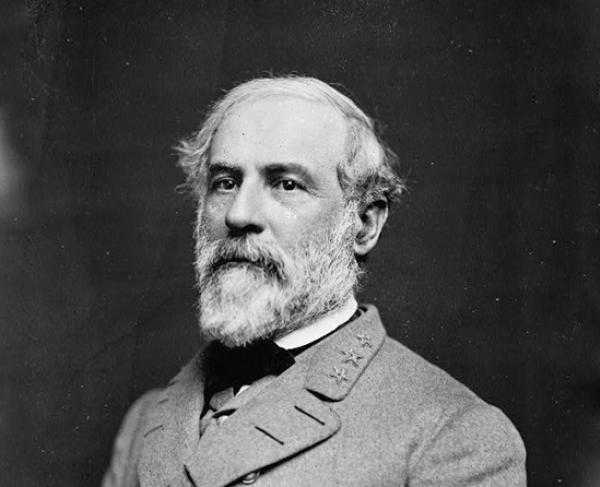Robert E. Lee

Born to Revolutionary War hero Henry "Light-Horse Harry" Lee in Stratford Hall, Virginia, Robert Edward Lee seemed destined for military greatness. Despite financial hardship that caused his father to depart to the West Indies, young Robert secured an appointment to the United States Military Academy at West Point, where he graduated second in the class of 1829. Two years later, he married Mary Anna Randolph Custis, a descendant of George Washington's adopted son, John Parke Custis. Yet with all his military pedigree, Lee had not set foot on a battlefield. Instead, he served seventeen years as an officer in the Corps of Engineers, supervising and inspecting the construction of the nation's coastal defenses. Service during the 1846 war with Mexico, however, changed that. As a member of General Winfield Scott's staff, Lee distinguished himself, earning three brevets for gallantry, and emerging from the conflict with the rank of colonel.
From 1852 to 1855, Lee served as superintendent of West Point, and was therefore responsible for educating many of the men who would later serve under him - and those who would oppose him - on the battlefields of the Civil War. In 1855 he left the academy to take a position in the cavalry and in 1859 was called upon to put down abolitionist John Brown’s raid at Harpers Ferry.
Because of his reputation as one of the finest officers in the United States Army, Abraham Lincoln offered Lee the command of the Federal forces in April 1861. Lee declined and tendered his resignation from the army when the state of Virginia seceded on April 17, arguing that he could not fight against his own people. Instead, he accepted a general’s commission in the newly formed Confederate Army. His first military engagement of the Civil War occurred at Cheat Mountain, Virginia (now West Virginia) on September 11, 1861. It was a Union victory but Lee’s reputation withstood the public criticism that followed. He served as military advisor to President Jefferson Davis until June 1862 when he was given command of the wounded General Joseph E. Johnston's embattled army on the Virginia peninsula.
Lee renamed his command the Army of Northern Virginia, and under his direction it would become the most famous and successful of the Confederate armies. This same organization also boasted some of the Confederacy's most inspiring military figures, including James Longstreet, Stonewall Jackson and the flamboyant cavalier J.E.B. Stuart. With these trusted subordinates, Lee commanded troops that continually manhandled their blue-clad adversaries and embarrassed their generals no matter what the odds.
Yet despite foiling several attempts to seize the Confederate capital, Lee recognized that the key to ultimate success was a victory on Northern soil. In September 1862, he launched an invasion into Maryland with the hope of shifting the war's focus away from Virginia. But when a misplaced dispatch outlining the invasion plan was discovered by Union commander George McClellan the element of surprise was lost, and the two armies faced off at the battle of Antietam. Though his plans were no longer a secret, Lee nevertheless managed to fight McClellan to a stalemate on September 17, 1862. Following the bloodiest one-day battle of the war, heavy casualties compelled Lee to withdraw under the cover of darkness. The remainder of 1862 was spent on the defensive, parrying Union thrusts at Fredericksburg and, in May of the following year, Chancellorsville.
The masterful victory at Chancellorsville gave Lee great confidence in his army, and the Rebel chief was inspired once again to take the fight to enemy soil. In late June of 1863, he began another invasion of the North, meeting the Union host at the crossroads town of Gettysburg, Pennsylvania. For three days Lee assailed the Federal army under George G. Meade in what would become the most famous battle of the entire war. Accustomed to seeing the Yankees run in the face of his aggressive troops, Lee attacked strong Union positions on high ground. This time, however, the Federals wouldn't budge. The Confederate war effort reached its high water mark on July 3, 1863 when Lee ordered a massive frontal assault against Meade's center, spear-headed by Virginians under Maj. Gen. George E. Pickett. The attack known as Pickett's charge was a failure and Lee, recognizing that the battle was lost, ordered his army to retreat. Taking full responsibility for the defeat, he wrote Jefferson Davis offering his resignation, which Davis refused to accept.
After the simultaneous Union victories at Gettysburg and Vicksburg, Mississippi, Ulysses S. Grant assumed command of the Federal armies. Rather than making Richmond the aim of his campaign, Grant chose to focus the myriad resources at his disposal on destroying Lee's Army of Northern Virginia. In a relentless and bloody campaign, the Federal juggernaut bludgeoned the under-supplied Rebel band. In spite of his ability to make Grant pay in blood for his aggressive tactics, Lee had been forced to yield the initiative to his adversary, and he recognized that the end of the Confederacy was only a matter of time. By the summer of 1864, the Confederates had been forced into waging trench warfare outside of Petersburg. Though President Davis named the Virginian General-in-Chief of all Confederate forces in February 1865, only two months later, on April 9, 1865, Lee was forced to surrender his weary and depleted army to Grant at Appomattox Court House, effectively ending the Civil War.
Lee returned home on parole and eventually became the president of Washington College in Virginia (now known as Washington and Lee University). He remained in this position until his death on October 12, 1870 in Lexington, Virginia.
Test Your Knowledge
Related Battles
17,304
13,460
23,049
28,063
152
500


